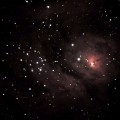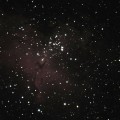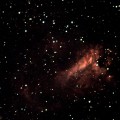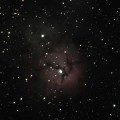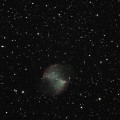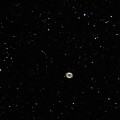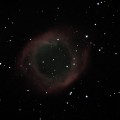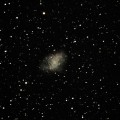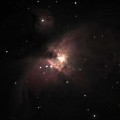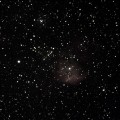Nebulas
| PINE MOUNTAIN OBSERVATORY Astrophotography with 8-inch Schmidt-Cassegrain telescope (SCT) “piggybacked” on PMO’s 24-inch telescope. |
| Any large cloud of gas and/or dust in space can be considered a nebula. (Plural Nebulas or Nebulae.) Some are associated with star formation, others with the death of stars. The nebulas that are the easiest to see are energized and emit their own light (“emission nebulas”), however there are also reflection nebulas and dark nebulas. |
| The “Big Four” star-forming (stellar nursery) regions of the summer sky: Lagoon Nebula (M8), Eagle Nebula (M16), Swan Nebula (M17) and Trifid Nebula (M20). These glow red due to energized hydrogen gas, although all also contain dark dust regions, and the Trifid contains a fainter blue reflection nebula. As star-forming regions, all are open star clusters in the making, and all are roughly 5,000 light years away. |
| Three well-known examples of “planetary” nebulas, formed when stars like the sun die: Dumbbell Nebula (M27), Ring Nebula (M57) and Helix Nebula (ngc 7293). These often have a blue-green color due to doubly ionized oxygen atoms. The superficial resemblance to the blue-green planets Uranus and Neptune was the origin of the name. However, these objects are often about a light-year in size … much bigger than the orbits of any of the planets. Eventually only a “white dwarf” star in the center will remain. |
| Two remnants of stars that completely exploded as supernovas: Crab Nebula (M1) in Taurus and the Veil Nebula in Cygnus. As seen from the Earth, the supernova that formed the Crab Nebula happened in 1054 A.D., whereas the origin of the Veil Nebula was prehistoric. The Crab Nebula contains a pulsar … a rapidly rotating neutron star … at its center. |
| Wintertime Nebulas: Left: The famous (and bright) Orion Nebula (M42), a star-forming region about 1,500 light years away.Center: The equally famous (but much harder to see) Horsehead Nebula in Orion, a dark nebula.Right: A much less well-known emission nebula, ngc 2467, near Orion. |
| Return to the main image page. |
